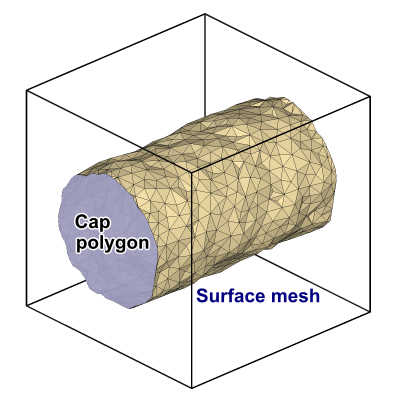Surface meshes
A surface mesh is a data object representing a closed, orientable two-dimensional manifold. Surface meshes in OVITO are typically generated using modifiers such as:
Construct surface mesh – Constructs a closed surface around a set of particles.
Create isosurface – Generates an isosurface from scalar field data.
Voronoi analysis – Computes the Voronoi tessellation of a particle system.
Coordination polyhedra – Creates polyhedral representations based on particle coordination.
The appearance of a surface mesh is controlled by a corresponding Surface mesh visual element, which is found under the Visual elements section of the pipeline editor.

Periodic surfaces
Surface meshes can exist within a periodic simulation domain, meaning their triangle faces may wrap around and connect vertices on opposite sides of a periodic simulation cell. OVITO automatically handles these periodic intersections, ensuring a correct non-periodic representation of the triangle mesh for rendering.
See also Periodic systems and cap polygons for more information on this topic.
Interior and exterior region
Since surface meshes are closed orientable manifolds, they define several spatial regions: one or more interior regions and an exterior region.
When a surface mesh is generated using the Construct surface mesh modifier, the enclosed volume represents the interior region filled with particles, while the exterior is the empty space (including pores).
There may be no interior region at all, meaning the exterior region is space-filling, resulting in a degenerate mesh with zero faces.
The opposite can occur as well (only in periodic domains): the interior region may extend over the entire periodic domain, leaving no exterior region. Again, this results in a degenerate surface mesh with zero faces.
See also
Exporting to a file
OVITO can export surface meshes as triangle meshes in a non-periodic form. During export:
Triangles intersecting periodic domain boundaries are truncated.
Cap polygons are generated to fill any gaps at the periodic boundary intersections.
To export a surface mesh, use OVITO’s file export function and select the VTK format.
See also